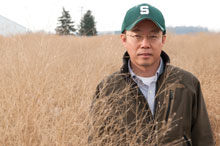Switchgrass May Replace Non-Renewable Fossil Fuels

Crop and soil scientist Doo-Hong Min
Could switchgrass (Panicum virgatum L.), a perennial warmseason grass that is native to North America and is also a renewable biofuel, be used to help power steam plants? And replace non-renewable fossil fuels such as petroleum and coal in the process? That's what Doo-Hong Min, an extension specialist in forages/bioenergy crops with MSU AgBioResearch, has been helping his research partners try to find out.
Based in the Upper Peninsula (UP) Research Center in Chatham, Min has been collaborating since 2007 with Cliffs Natural Resources, an international mining and resources company, and one of its subsidiaries, Renewafuel, LLC, which provides renewable biomass energy solutions for industries, institutions, and utilities. The companies have been testing "cubes" made from plant biomass such as switchgrass, along with other products such as wood, and corn stover (i.e., post-harvest leaves, stalks and cobs) as possible sources of fuel.
Min, whose research focuses on switchgrass and forages (i.e., plants grown for animal grazing or harvesting) has tested nine varieties of switchgrass in the UP Research Center and Renewafuel also has a test site in the area. Min has been working with the companies' scientists to help them identify which varieties of switchgrass are best to grow in the UP and how best to grow them.
Michelle Jarvie, an environmental engineer with Cliffs who has been working on the test plot, said that "Dr. Min's research and advice have been invaluable to us," and "his expertise has made it easier for us to start working with this new crop."
Min's research also benefits local farmers. Switchgrass can, once planted, last 15-20 years as it has a massive root system with rhizomes (underground stems). It is very low maintenance and can be planted in fallow fields, thereby adding value to them. As well as serving as a bioenergy source, switchgrass can be used as livestock feed for many types of animals during the summer slump of cool-season grasses.
Renewafuel is currently working to modify its woodchip cubing machine to blend woodchips with switchgrass and other feedstock. Once these modifications are complete, the company plans to buy switchgrass from growers near its recently opened biomass fuel production plant in the Telkite Technology Park. The plant is located on the site of the former K. I. Sawyer Air Force base in winn, Marquette County, which closed in 1995, resulting in the loss of more than 4,500 jobs. Min has been working with growers to increase the amount of switchgrass by testing different varieties in nearby Dickinson County.
It is estimated that Renewafuel's $19-million plant will produce 150,000 tons of biomass cube fuel "pellets" annually when it is at full production. The company's research and development facility in Battle Creek, Michigan, is expected to be able to produce another 60,000 tons per year. Initially 25 employees (many from local areas) have been employed at the new plant, and additional "spinoff" jobs could be created to help the local and regional economy.